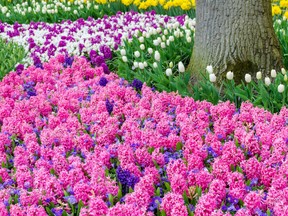
Reviews and recommendations are unbiased and products are independently selected. Postmedia may earn an affiliate commission from purchases made through links on this page.
Article content
It’s hard to imagine those little dried-up things will produce a beautiful flower next spring, but year after year, we believe
Advertisement 2
Article content
All gardeners are first and foremost dreamers, and the annual ritual of buying and planting spring bulbs perfectly symbolizes that leap of faith.
How can this puny, dried-out little object actually produce a beautiful flower, months after you bury it in the ground?
And yet year after year, autumn after autumn, the catalogues and store shelves groan with hundreds of these miniature promises of spring – and we do it all again.
When we think of bulbs, most people think of spring bloomers such as crocuses, daffodils and tulips, but actually there are types that bloom in every season – from before the snow melts (snowdrops, Japanese anemones), throughout spring and summer (various types of tulips, lilies, dahlias), and well into autumn (autumn crocus). You could conceivably grow a garden with nothing but bulbs in it and have reliable colour from snow to snow.
Article content
Advertisement 3
Article content
Growing flowers from bulbs is actually one of the easiest, no-fail forms of gardening there is. But over a lifetime of planting bulbs of all kinds, I’ve learned a few tips along the way.
First and foremost, have a clear idea of where you’ll plant your bulbs before you click “Confirm Order.” Consider the height, bloom time, colour and shape, sun requirements (that doesn’t matter so much when it’s in bloom, but it makes a big difference during the leaf stage, when it’s gathering energy for next year’s show) and how much space you’ll be able to give each bulb.
Make a note now of which spots in your garden tend to start out bare and fill in as spring wears on, such as next to later perennials, like hostas or daylilies.
For smaller bulbs like crocuses, snowdrops and those tiny daffs known as Johnny Jump-Ups, put them where you’ll be able to see them close-up next spring; the front edge of a city garden, for example, cheers the heart of all who walk past.
Advertisement 4
Article content
Avoid planting too close to shrubs, directly under trees, or anywhere that is chronically either too dry or where water tends to pool after rains. Also, be careful that later plants won’t crowd the leaves post-bloom.
I like to plant them in clusters of up to a dozen rather than ones and twos; it makes a bigger show and looks more natural to me.
Mind you, that sometimes means that they can get overcrowded and stop blooming after a few years and need replanting, but I think it’s a small price to pay.
Plant them as soon as you can after they arrive. Dig a hole about three to four times as deep as the bulb’s height (or whatever the instructions say, if there are any), and wide enough to place them at least one to one-and-a-half times their width apart.
Advertisement 5
Article content
Rough up the soil in the bottom of the hole a bit, then gently nestle each bulb into place, pointy side up.
Cover with soil just up to the tops of the bulbs, tamp down gently with your fingers, then add several handfuls (or trowel-fuls) of compost or topsoil mixed with organic bulb fertilizer. Tamp down and finish filling in the hole.
Some bulbs “naturalize” (that is, spread by themselves) readily, especially crocuses and some daffodils that haven’t been too heavily hybridized.
I once read in a vintage gardening book about a way to simulate this naturalizing effect: take the bag of bulbs and walk backwards through your garden, throwing them at random over your shoulder.
Plant them where they fall. (Granted, this method might work better in a rambling English country garden than a modern city garden, but I like the idea anyway.)
Other bulbs have a lifespan of just a few years. Some tulips in particular will make a spectacular show for the first three or four years, then revert to just sending out little puny leaves.
When this happens, dig them up, and plant some nice new ones – consider it a chance to indulge your gardening dreams once again.
Please feel free to write in with questions, to comment or to share your
own city gardening adventures. Write to me at marthasgarden07@gmail.com.
Article content
